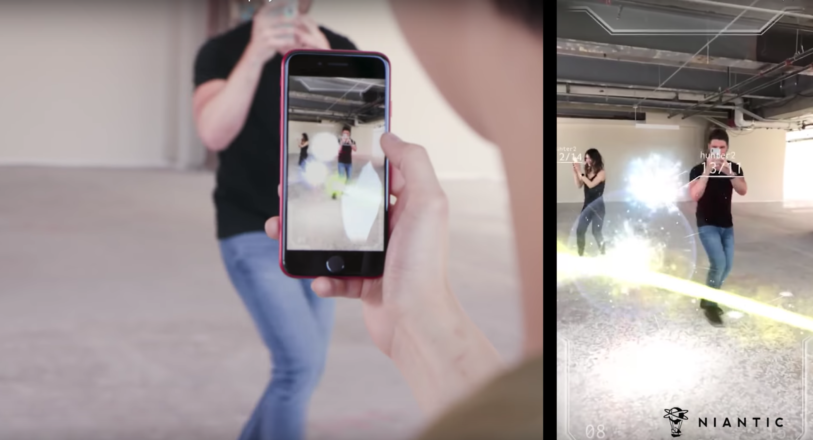Niantic, the maker of the hit augmented reality game Pokémon Go, today announced it’s teaming up with a group of 5G carriers from across North America, Europe, and Asia to help high-quality AR experiences proliferate to millions of new users, as 5G technology capable of handling rich AR is deployed on wireless networks around the world.
As part of what it’s calling the Planet-Scale AR Alliance, Niantic will provide the carriers with a set of AR applications. The initial alliance partners—Deutsche Telekom, EE, Globe, Orange, SK Telecton, Softbank, TELUS, and Verizon—will be able to offer the experiences in their retail stores or for download to 5G-enabled handsets later this year.
During the next phase of the alliance, says Niantic CEO John Hanke, Niantic will work with the carriers to distribute the applications and build consumer awareness globally about what’s possible with AR on 5G networks.

“The longer-tail piece is the heart of it,” says Hanke. “Integrating the [5G] networks of the carriers and the edge computing portion of that into our global platform so that we can deploy these things at scale to millions and millions of users.”
Although Niantic is best known for Pokémon Go, which became a monster success in 2016, it’s also released several other large-scale massively multiplayer AR games, including Ingress and Harry Potter: Wizards Unite. And last year, it unveiled its Planet-Scale AR Platform, a set of tools and technology aimed at giving third-party developers what they need to build new large-scale AR experiences. Those outsiders, including winners of Niantic’s developer contests, will contribute some of the experiences available to members of the new alliance.
5G needs AR more than AR needs 5G
Beyond the potential short- and long-term benefit to AR developers, including Niantic itself, the pact is a necessary move for 5G carriers who need something to show their users the value of the next-generation wireless networks as they transition from current 4G networks. “Many of today’s 4G applications will simply work better or evolve in 5G,” says Reticle Research principal analyst Ross Rubin. “But it’s tough to get people excited about that. AR is about the only ‘pillar’ tech today . . . that could fundamentally change how we interact with the world if it can gain access to the high-bandwidth, low-latency, and eventually broad coverage of 5G.”
That dynamic is even more urgent for wireless carriers during the coronavirus era. “They’ve got to keep people paying their smartphone bills during the pandemic, and during a downtime when oftentimes they’re not having to be mobile, and not having to rely on the smartphone and mobility,” says Brian Blau, senior advisor at ImmersivEdge Advisors. “They’re sitting at home and using Wi-Fi, and that’s getting them by.”
The potential to offer unique, interactive content such as AR experiences is ” an opportunity to keep in front of people and remind them about how important mobile is,” adds Blau.
In short, Rubin says, 5G needs AR more than AR needs 5G, because 5G needs defining applications with the potential to lure large numbers of users. And because AR already works reasonably well on existing networks, he adds, its user base can conceivably grow even without needing next-generation technology.
Software now, hardware later
While the alliance is largely geared toward expanding AR software offerings on members’ networks, it’s also likely it will eventually impact hardware.
Last year, Niantic inked a partnership with Qualcomm to create a reference design for augmented reality glasses. Hanke acknowledges that “you could expect” that electronics manufacturers will eventually be brought into the new alliance along with the wireless carriers who make up the initial membership. After all, he says, the mission of the Qualcomm reference design project is to help bring AR hardware to market, which by design would mean Niantic working hand in hand with hardware partners.
For AR to be a driver of meaningful adoption of 5G networks, the carriers know that they need to offer more than entertainment.
As Niantic moves forward with its platform, it does so from a position of strength: It’s probably the most high-profile developer of AR experiences. But it’s also fighting a pitched battle with Google and Apple, among others, to define the future of AR. The tech giants, especially Apple, are buying immersive technology companies left and right and trying to build the kind of broad, global, live 3D platform that Niantic has already hosted millions of people in.
For AR to be a driver of meaningful adoption of 5G networks, the carriers know that they need to offer more than entertainment. They need to offer information, ways to navigate the real world, and metacontent, says Rubin. Niantic has spent years populating geographic locations around the world with characters from its games; to get to the next stage, it needs to think about expanding well beyond that, to useful things such as products on store shelves, books in libraries, and real-time directions. Google is already starting to do some of these things with its Google Lens technology.
For now, though, Niantic is happy just to help more people understand the power of AR, and it’s counting on its new alliance to make that happen. The company will measure the success of the alliance by the number of people it reaches and the awareness of AR it builds. It’s working toward a world in which people have AR glasses and where physical locations across the globe are annotated with AR content. “It’ll be several years in the future before you realize that,” Hanke says. “But the goal is to give a taste of where we’re headed.”
Recognize your brand’s excellence by applying to this year’s Brands That Matter Awards before the early-rate deadline, May 3.
